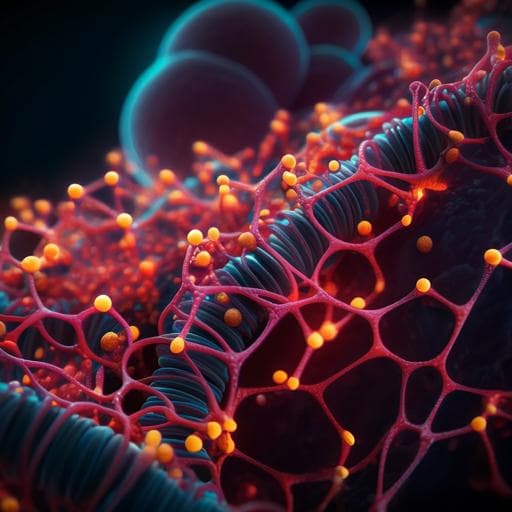
Engineering and Technology
A flexible neural implant with ultrathin substrate for low-invasive brain-computer interface applications
Z. Guo, F. Wang, et al.
Discover the revolutionary potential of a flexible brain-computer interface (BCI) device that promises to enhance neural signal quality while minimizing trauma. This innovative microdevice, developed by a team from Shanghai Jiao Tong University, enables low-invasive brain communication with remarkable longevity of neuronal signal recording post-implantation.
~3 min • Beginner • English
Introduction
The study addresses the challenge that rigid or bulky neural implants have much higher elastic modulus and bending stiffness than brain tissue, leading to acute and chronic tissue damage, glial scarring, and degraded signal quality. Prior MEMS-based devices like Utah and Michigan probes excel in precision but still suffer from mechanical mismatch. Flexible polymer probes can mitigate immune responses by reducing bending stiffness and cross-section, but ultrathin devices often require costly fabrication and may raise biocompatibility concerns depending on materials. This work aims to develop a MEMS-fabricated flexible neural implant with an ultrathin polyimide (PI) substrate and a small cross-section to lower bending stiffness, reduce implantation trauma, and maintain stable neural recordings. The device integrates Pt-black-modified electrodes for LFP and spike recording and uses an optimized silicon shuttle with capillary microgrooves and PEG bonding to enable accurate, low-damage implantation.
Literature Review
The paper situates its contribution within advances in flexible intracortical probes designed to reduce mechanical mismatch and immune response. Examples include minimally invasive probes with small cross-sections per electrode improving immune acceptance, flexible polyimide neural threads implantable by a robot, and SU-8-based ultraflexible implants achieving subcellular footprints via advanced lithography. Bioinspired designs mimicking neuronal axon mechanics achieve bending stiffness comparable to axons, supporting seamless interfaces. Limitations of prior art include high cost for electron-beam lithography and debated biocompatibility of SU-8. Commercial photosensitive polyimides such as Durimide have demonstrated in vitro and in vivo biocompatibility and are compatible with photolithography, motivating their selection for this work.
Methodology
Design: The flexible implant targets low bending stiffness by minimizing substrate thickness and width while using a compliant material (photosensitive PI, Durimide 7505). Electrode layout includes four macroelectrodes (6000 µm² each, 300 µm spacing) for LFP and four 20 µm-diameter microelectrodes for spikes, evenly distributed near the tip. Anchoring structures on both sides of the PI shank limit post-implant micromotion. A rigid silicon shuttle with a T-shaped stiffener on the backside increases rotational inertia without increasing implanted cross-section, enhancing the critical buckling force for insertion. The shuttle surface integrates four 20 µm-wide microgrooves forming a capillary channel; a 1 µm SiO2 coating reduces PEG contact angle to promote capillary filling and bonding.
Temporary bonding and insertion aid: Polyethylene glycol (PEG) is used to temporarily bond the PI device to the shuttle. PEG dissolution times in PBS were characterized; PEG of 8000 g/mol was selected to balance insertion time and handling. Capillary forces in the microgrooves distribute molten PEG along the shuttle, enabling uniform, tight coupling; upon implantation, PEG dissolves to release the implant.
Fabrication: The flexible PI substrate and silicon shuttle are fabricated separately by MEMS processes. PI films are formed by spin coating (e.g., 3000 rpm for ~2.5 µm; 1500 rpm for ~5 µm). To achieve nanoscale thickness, methyl-2-pyrrolidinone (MNP) is mixed with the PI precursor at controlled mass ratios, enabling 200 nm, 500 nm, and 1 µm films. Process flow for the PI device: (1) pattern bottom PI; (2) deposit/pattern metal interconnects (20 nm Cr / 300 nm Au); (3) pattern top PI; (4) pattern electrode metal; (5) release in hydrochloric acid solution. Electrodes are electroplated with Pt-black to increase charge storage capacity and lower impedance. The silicon shuttle is defined by photolithography and deep reactive ion etching (DRIE), followed by SiO2 deposition and microgroove formation.
Assembly: Shuttle cleaned by oxygen plasma and kept at 80 °C; PEG pellets (8000 g/mol) placed on the shuttle shank and melted, filling the microgrooves by capillarity. The flexible PI substrate is transferred and self-aligned onto the shuttle via capillary forces; additional PEG applied at the end to strengthen bonding. After cooling/solidification, the shuttle is mounted to a 3D-printed resin board. Anisotropic conductive film (AC2056R) connects a flexible printed circuit (FPC) to the device.
Mechanical characterization: Tensile tests on 5 µm and 10 µm thick PI substrates performed with a dynamic thermomechanical analysis system to obtain force–displacement and stress–strain characteristics; Young’s modulus derived from the linear elastic region. Finite element analysis (ABAQUS) evaluates maximum von Mises stress under bending diameters of 1.2 mm, 0.8 mm, and 0.5 mm for different thicknesses. Practical bendability assessed by wrapping a 5 µm PI substrate around a 0.8 mm needle using water capillarity.
Thickness scalability and profilometry: Nanoscale PI films (200 nm, 500 nm, 1 µm) obtained by varying PI:MNP ratios; thickness and step profiles measured by profilometry (Dektak XTL). Film uniformity inferred from thin-film interference color uniformity across patterns. Bending stiffness estimated using K ∝ E·b·h³/12 and calculated for a 1 µm-thick device.
In vivo assessment (as reported in abstract): The assembled device was implanted with the silicon shuttle into mouse cortex, demonstrating penetration and stable neural signal recording up to one month post-implantation.
Key Findings
- Mechanical compliance: For PI substrates of 5 µm and 10 µm thickness, maximum tensile forces before fracture were 52 mN and 107 mN, respectively. The measured Young’s modulus of the fabricated PI device was 3.14 GPa.
- Flexibility vs. stress: Finite element analyses under bending diameters of 1.2 mm, 0.8 mm, and 0.5 mm showed lower maximum von Mises stress for thinner substrates, indicating reduced likelihood of tissue damage during bending. A 5 µm-thick PI substrate could wrap around a 0.8 mm needle tip via water capillarity.
- Nanoscale thickness control: By mixing PI with MNP, uniform PI films of 200 nm, 500 nm, and 1 µm thickness were fabricated; the original undiluted PI produced ~2.3 µm films. A total device thickness of ~1 µm was confirmed by profilometry.
- Ultra-low bending stiffness: The calculated bending stiffness for the 1 µm-thick device was 2.6 × 10^-14 N·m², smaller than most reported polymer implants and approaching axonal stiffness.
- Implantation aid: A silicon shuttle with a backside stiffener increased critical buckling force without increasing implanted cross-section; surface microgrooves and a hydrophilic SiO2 layer enabled capillary wicking of PEG for strong temporary bonding.
- Electrode performance enhancement: Pt-black modification increased charge storage capacity and reduced electrode impedance (qualitatively reported).
- In vivo performance: The device’s small cross-section reduced implantation trauma, and neuronal signals were recorded up to one month post-implantation.
Discussion
The results support the central premise that reducing implant thickness and bending stiffness improves mechanical compatibility with brain tissue, thereby reducing trauma and stabilizing the electrode–tissue interface. The ultrathin PI substrate—engineered down to ~1 µm total thickness—achieves bending stiffness on the order of 10^-14 N·m², comparable to neuronal processes, which is expected to minimize micromotion-induced damage. Despite the reduced thickness, mechanical tests indicate sufficient tensile strength (e.g., 52 mN at 5 µm, 107 mN at 10 µm) to withstand handling and insertion when aided by the silicon shuttle. The shuttle’s T-stiffener and capillary PEG bonding ensure precise implantation without enlarging the implanted cross-section, preserving the low-invasive objective. Pt-black-modified electrodes enable both LFP (macroelectrodes) and spike (20 µm microelectrodes) recordings by enhancing charge storage and lowering impedance. In vivo outcomes—sustained neural recordings one month after implantation—are consistent with reduced tissue response and stable interfaces. Overall, the device architecture effectively addresses the need for a low-invasive, flexible BCI capable of chronic neural signal acquisition.
Conclusion
This work demonstrates a MEMS-fabricated flexible neural implant featuring an ultrathin PI substrate, Pt-black-enhanced electrodes for LFP and spike recordings, and an optimized silicon shuttle with capillary PEG bonding for accurate, minimally invasive implantation. The approach achieves extremely low bending stiffness (≈2.6 × 10^-14 N·m² at ~1 µm total thickness) while maintaining adequate mechanical robustness and enabling month-long in vivo recordings, indicating potential for improved chronic performance and reduced immune response. Future work could focus on extended chronic studies to assess long-term stability and biocompatibility beyond one month, detailed electrochemical characterization over time, optimization of the thickness-strength trade-off for different brain regions and species, and integration with higher-channel-count architectures and automated insertion systems.
Limitations
- Trade-off between flexibility and strength: Thinner substrates reduce bending stiffness but lower tensile strength, potentially compromising mechanical robustness during handling or chronic micromotion.
- Increased permeability: Thinner films allow faster body-fluid permeation for materials of similar permeability, which may challenge long-term encapsulation and reliability.
- Partial in vivo duration: Reported in vivo recording duration is one month; longer-term stability and tissue response are not detailed in the provided text.
- Limited quantitative electrochemistry in text: While Pt-black improvements are described qualitatively, detailed impedance spectra and charge storage metrics are not provided in the excerpt.
Related Publications
Explore these studies to deepen your understanding of the subject.







